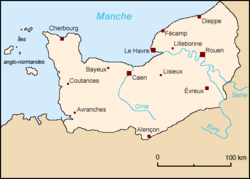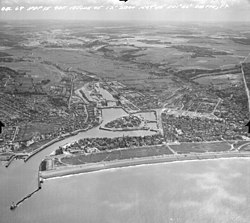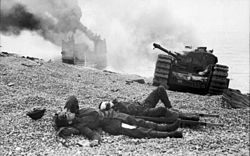Dieppe Raid
The Dieppe Raid, also known as the Battle of Dieppe, Operation Rutter and later Operation Jubilee, was an Allied attack on the German-occupied port of Dieppe, France. The attack took place on the northern coast of France on 19 August 1942, during World War II.
| Dieppe Raid | |||||||
|---|---|---|---|---|---|---|---|
| Part of the North West Europe Campaign | |||||||
 Dieppe's chert beach and cliff immediately following the raid on 19 August 1942. A Dingo Scout Car has been abandoned. | |||||||
| |||||||
| Belligerents | |||||||
|
|
| ||||||
| Commanders and leaders | |||||||
|
|
| ||||||
| Strength | |||||||
|
Infantry
Royal Navy Royal Air Force |
302nd Static Infantry Division ~1,500 men Does not include Luftwaffe and Kriegsmarine | ||||||
| Casualties and losses | |||||||
|
Ground forces Canada: 907 killed, 586 wounded, 1,946 captured[2] United Kingdom: 275 commandos Royal Navy 1 destroyer 33 landing craft 550 dead and wounded Royal Air Force 64 Supermarine Spitfire fighters 20 Hawker Hurricane fighters 6 Douglas Boston bombers 10 North American Mustang Mk 1 fighters 62 killed, 30 wounded, 17 captured |
Ground forces Germany: 311 dead, 280 wounded Luftwaffe 23 Fw 190 25 Dornier Do 217 | ||||||
The attack began at 5:00 a.m., and by 10:50 a.m. the Allied commanders had toretreat. Over 6,000 infantrymen, mostly Canadian, were supported by a Canadian armoured regiment. They were also helped by a strong force of the Royal Navy and a smaller Royal Air Force group.
The goal was to capture a major port for a short period and to gather information. Upon their retreat, the Allies also wanted to destroy coastal defences, port structures and important buildings. The raid was also intended to improve morale and demonstrate the United Kingdom's commitment to attack the Western front in Europe.
None of the goals was achieved since there was not enough Allied artillery support. The troops were trapped on the beach by obstacles and German gunfire. After less than 10 hours since the first landings, the last Allied troops had been killed, evacuated or captured by the Germans.
Instead of showing the British commitment, the terrible number of Allied deaths showed that the Allies would not be ready to invade France for a long time. The attack helped the Allies gather some information.
A total of 3,623 of the 6,086 men (almost 60%) who went ashore were killed, wounded or captured.[3] The Royal Air Force did not get the Luftwaffe to start a battle. The Royal Air Force lost 96 aircraft (at least 32 to being shot down or accidents), compared to 48 lost by the Luftwaffe.[4]
The Royal Navy lost 33 landing craft and one destroyer. The events at Dieppe affected the plans for the North African (Operation Torch) and Normandy landings (Operation Overlord).
Background
The British decided that the Dieppe attack could be planned within a month. They were very careful to keep the attack secret. No records were kept of the plans.
After the evacuation of the British Expeditionary Forces from Dunkirk in May 1940, the British started to plan an attack force. It would use new ways of doing sea landings on beaches (amphibious warfare).
The British started planning to see if they could capture a port. That would allow them to test out how to use ships in the attack and to test new equipment.
Dieppe, a coastal town in France, is built along a long cliff by the English Channel. In 1942, the Germans set up two large artillery batteries at Berneval-le-Grand and Varengeville. One important consideration for the British planners was that Dieppe was within range of the Royal Air Force's fighter aircraft.[5]
There was also pressure from the Soviet government to attack the Germans in Western Europe. By early 1942, the Wehrmacht's Operation Barbarossa attacks had not destroyed the Soviet Union.
However, the Germans moved into southern Soviet territory and pushed toward Stalingrad. Joseph Stalin demanded that the Allies attack in France to force the Germans to move 40 divisions away from the Eastern Front, which would make the fighting easier for the Red Army.[6]
Plan
The Dieppe Raid was a major attack planned by Vice-Admiral Lord Mountbatten.
The attacking force would consist of 5,000 Canadians, 1,000 British troops, and 50 United States Rangers.[7]
It was originally planned in April 1942 and codenamed Operation Rutter. The Allies planned to do a major attack on a German-held port on the French coast and to hold it for two tides. They would destroy enemy buildings and defences before withdrawing.
This plan was approved in May 1942. It included British parachute units attacking German artillery batteries. The Canadians would land on the beaches and attack.[8] The parachute operation was cancelled, and instead, No. 3 Commando and No. 4 Commando would land by sea and attack the artillery batteries.[7]
Land component
The Canadian government wanted Canadian troops to do some of the fighting. The 2nd Canadian Infantry Division, commanded by Major General John Hamilton Roberts, was selected for the main force.[7] The plan called for an attack without any heavy air bombing.
Too little bombing was one of the main reasons for the attack's failure. Some people think that air and naval bombing was not done to limit casualties of French civilians in the port.[9]
The Dieppe landings were planned on six beaches. Four were in front of the town, and two to the eastern and western sides.
Armoured support was provided by the 14th Army Tank Regiment (The Calgary Regiment (Tank). and 58 of the new Churchill tanks would be sent ashore using the new landing craft tank (LCT).[10] In addition, three of the Churchills had flame-throwers and all could operate in the shallow water near the beach.
The Royal Navy would supply 237 ships and landing craft.[7] However, pre-landing naval gunfire support was limited, consisting of six Hunt class destroyers with 4-inch guns. The Royal Air Force would supply 74 squadrons of aircraft, of which 66 were fighter squadrons.[7]
Intelligence
There was not much information about the beaches. There were German gun positions on the cliffs, but they had not been spotted. The planners thought that Dieppe was not heavily defended and that the beaches were suitable for landing infantry and armored fighting vehicles.[11]
German forces

The German forces at Dieppe were ready for the attack. They had been warned by French double agents that the British were planning some action in the area. They had also detected increased radio talk and landing craft being gathered together in the southern British coastal ports.[7]
Dieppe and its cliffs were well defended. The 1,500 troops were placed along the beaches of Dieppe and the nearby towns and covered all likely landing places.
The Germans had machine guns, mortars and artillery. The city and the port was protected.
The Luftwaffe forces were Jagdgeschwader 2 (JG2) and Jagdgeschwader 26 (JG26), with 200 fighters, mostly the Fw 190. There were about 100 bombers from Kampfgeschwader 2 (KG2), Kampfgeschwader 45 (KG45), and Kampfgeschwader 77 (KG77), mostly Dornier 217s.
Initial landings
The Allied fleet left the southern coast of England on the night of 18 August 1942. The Canadians left from the Port of Newhaven. The fleet of eight destroyers and motor gun boats to protect the landing craft and motor launches were preceded by minesweepersm wgucg cleared paths through the English Channel for them.
The initial landings began at 04:50 on 19 August. There were attacks on the two artillery batteries on the sides of the main landing area.
On their way in, the landing craft and escorts heading towards Puys and Berneval ran into a small German group of ships and exchanged fire at 03:48.[7]
Yellow Beach
The goal for Lieutenant Colonel John Durnford-Slater and No. 3 Commando was to do two landings 8 miles (13 km) east of Dieppe to destroy the coastal artillery battery near Berneval. The battery could fire upon the landing at Dieppe 4 miles (6.4 km) to the west.
The craft carrying No. 3 Commando approached the coast to the east. They were not warned of the approach of a German convoy that had been found by British "Chain Home" radar stations at 21:30.
German S-boats escorting a German tanker torpedoed some of the landing craft and damaged the escorting Steam Gun Boat 5.
Motor Launch 346 and Landing Craft Flak 1 fired on the German boats. The group got spread out with some losses, and the enemy's coastal defences were alerted.
Only 18 commandos got near the German artillery battery. They fired guns at the Germans. Although they were unable to destroy the artillery, they caused problems for the German artillery troops. The commandos had to pull back because there were so many enemy troops.[7][8]
Orange Beach

The goal for Lieutenant Colonel Lord Lovat and No. 4 Commando (including 50 United States Army Rangers) was to do two landings 6 miles (9.7 km) west of Dieppe. They had to destroy the coastal artillery battery Hess at Blancmesnil-Sainte-Marguerite. Landing on the right side, they climbed the hill and attacked. They destroyed the artillery battery of six 150 mm guns. That was the only success of Operation Jubilee.[7] The commando then withdrew at 07:30, as planned.[5]
Most of No. 4 returned to England. This part of the raid was seen as a good example of how the Royal Marine Commando should attack during landings. Lord Lovat was awarded the Distinguished Service Order,[12] and Captain Patrick Porteous No. 4 Commando, was awarded the Victoria Cross.[13][14][15]
Blue beach

The naval battle between the small German convoy and the craft carrying No. 3 Commando had made the German defenders at Blue beach aware of the attack.[5] The landing near Puys by the Royal Regiment of Canada and three platoons from the Black Watch of Canada and an artillery group was ordered to destroy machine gun and artillery batteries protecting the Dieppe beach.[5]
They were delayed by 20 minutes and the smoke, which should have hidden their attack, had lifted. The Germans were ready in their defensive positions for the landings.[5] The well-fortified German forces fired guns at the Canadian forces that did land on the beach.
As soon as they reached the shore, the Canadians found themselves unable to move forward.[5] The Royal Regiment of Canada had many deaths. Of the 556 men in the regiment, 200 were killed and 264 captured.[5]
Green beach
On Green beach, at the same time that No. 4 Commando had landed, the South Saskatchewan Regiment went towards Pourville. They landed at 04:52 without being detected. The regiment managed to leave their landing craft before the Germans could start firing their guns.
The regiment had to enter Pourville to cross the river by the only bridge.[5] Before they managed to reach the bridge, the Germans had put machine guns and anti-tank guns there which stopped them. With dead and wounded Canadians lying on the bridge, Lieutenant Colonel Charles Cecil Ingersoll Merritt, the commanding officer, crossed the bridge several times. He wanted to show his soldiers that the bridge could be crossed. Merritt was awarded the Victoria Cross.[13]
Pourville radar station
One of the goals of the Dieppe Raid was to discover the technology of a German radar station.
RAF Flight Sergeant Jack Nissenthall, a radar specialist, was to attempt to enter the radar station and learn its secrets. If he were about to be captured, the soldiers with him had to kill him. He knew many secrets about Allied radar. He also carried a cyanide pill to take if he was captured. [16]
Nissenthall and his men could not enter the radar station because of the strong German defences. Nissenthall managwed to cut all of the telephone wires.
Dieppe Raid Media
Dieppe is in the département of Seine-Maritime, in Normandy Landing Craft Mechanised Mark 1 returning from the beaches during the raid
Canadian wounded and abandoned Churchill tanks after the raid. A landing craft is on fire in the background.
Daimler Dingo armoured car and two Churchill tanks bogged down on the shingle beach. The nearer Churchill tank has a flame thrower mounted in the hull, and the rear tank has lost a track. Both have attachments to heighten their exhausts for wading through the surf.
German soldiers examine a Churchill tank at Dieppe
References
- ↑ Król, pp. 95-96, 250
- ↑ Dieppe Raide Archived 2013-03-06 at the Wayback Machine, Alex Herd, Canadian Encyclopedia
- ↑ Hamilton, Nigel (1981). Monty: The Making of a General. London: Hamish Hamilton Ltd. ISBN 0-241-10583-8. "Dieppe" p.546-558
- ↑ Franks 1998, pp. 56–62.
- ↑ 5.0 5.1 5.2 5.3 5.4 5.5 5.6 5.7 "Dieppe raid." Archived 2014-03-06 at the Wayback Machine Canada in World War II, 7 June 2010.
- ↑ Whitaker 1992, p. 29
- ↑ 7.0 7.1 7.2 7.3 7.4 7.5 7.6 7.7 7.8 Thompson, Julian. "The Dieppe Raid." BBC (World Wars in Depth series), 6 June 2010.
- ↑ 8.0 8.1 "Operation Jubilee." Combined Operations, 7 June 2010.
- ↑ Hall, David. "The German View of the Dieppe Raid." Archived 2018-08-20 at the Wayback Machine Military History Lecture, Laurier Centre for Military Strategic and Disarmament Studies, Wilfrid Laurier University, Waterloo, 13 October 2011.
- ↑ Henry 1993, p. 6.
- ↑ Atkin 1980, p. 23.
- ↑ No. 35729. 2 October 1942. p. 4328. https://www.thegazette.co.uk/London/issue/35729/supplement/4328
- ↑ 13.0 13.1 No. 35729. 2 October 1942. pp. 4323–4324. https://www.thegazette.co.uk/London/issue/35729/supplement/4323
- ↑ No. 35730. 2 October 1942. p. 4339. https://www.thegazette.co.uk/London/issue/35730/supplement/4339
- ↑ Dunning 2003, pp. 65–87.
- ↑ Atkin 1980, p. 136.
- ↑ Only air and naval forces. The Polish forces included the No. 302, 303, 306, 308 and No. 317 Fighter Squadrons of the Polish Air Forces fighting alongside the RAF,[1] as well as the ORP Ślązak destroyer









